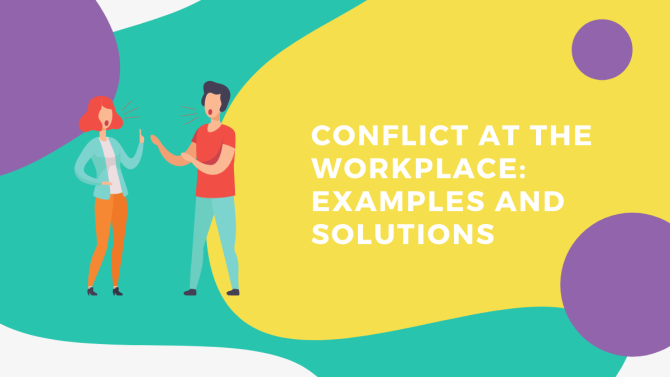
Employees come from different backgrounds, have unique personalities, and adhere to varying work styles. Because of this, conflicts are inevitable and can get in the way of the company’s performance. This article will discuss workplace conflicts and analyze conflict at workplace examples to help you properly manage the situation.
Why Should You Prioritize Conflict Resolution?
Problems within the workplace should be dealt with before they escalate and harm the employees’ relationships, productivity, and workplace morale. At the same time, you should aim for results that aid in employee growth and keeps the company dynamic.
Conflicts can be between two individuals, an individual and a group, or two parties. These disagreements are expressed through various ways, such as noncooperation, insults, and bullying.
Negative effects of workplace conflicts include the following:
- Emotional stress
- Work disruption
- Low-quality outputs
- Project/s failure
- Absenteeism
- Resignation or Termination
Common Causes of Conflict at the Workplace
“Prevention is better than a cure” doesn’t just apply to illnesses. It also fits conflict management. Although entirely avoiding conflicts is impossible, it’s still important to identify common causes and reduce their chances of happening.
1. Miscommunication
Miscommunication or the inability to properly convey an idea or information leads to misunderstandings. To avoid miscommunication, apply and teach the following:
- Say exactly what you mean. Be clear and concise that there’ll be no room for guesses or assumptions.
- Be careful of nonverbal cues or behaviors. Check your body language, facial expression, and tone of voice.
- Communication is a two-way process. It’s not good to just speak without listening. Be open to other employee’s ideas and try to learn from each other.
2. Resistance to Change
Not everyone can readily embrace change, and some people need time to adjust to it. Changes can bring about confusion, denial, and even anger when employees fail to carry them out. To have a smoother transition when introducing changes, you can do the following:
- Explain why change is necessary. State the reasons behind the changes so employees can understand and be more accepting of them.
- Involve your employees. Allow each employee to be part of the process so they don’t feel left out.
3. Poor Work Habits
Bad habits will spark conflict and affect your team. It’s important to identify these habits in order to address them. For example:
- Tardiness in both coming to work and meetings
- Inability to meet deadlines
- Spreading gossips around the office
Other Causes of Conflicts
Recognizing the sources and types of conflicts in the workplace is critical to applying the necessary steps needed to handle them. The sources of conflict can be divided into two:
1. Personal Factors
Below are some examples of internal factors that lead to conflict:
Role Conflict
This happens when an employee’s skills and abilities don’t match the required skill set of the job. Some organizations don’t have well-defined roles for their positions resulting in the overlapping of work. Overlapping roles make the team less productive and confuse responsibilities. Avoiding role conflicts starts with properly defining job descriptions.
Goal Conflict
This type of conflict happens when plans or strategies can’t be properly executed due to different goals. Varying beliefs on what goals to prioritize will deter employees from being organized. They may even sacrifice the company’s vision and mission just to prove that their idea is better than the other.
Intrapersonal or Intra-Individual Conflict
These are conflicts within an individual and may happen when an employee is assigned a task that goes against his personal principles or values. It can also develop when individuals feel like they don’t deserve a position because they lack intelligence or talent.
2. Structural Factors
Let us now look at some external sources of conflicts:
Interpersonal Conflict
Interpersonal conflict occurs between two or more individuals within the same role or function who have different opinions and goals. A common example is when a boss berates a subordinate for a mistake they made.
Intergroup Conflict
On the other hand, intergroup conflict in the workplace exists between two groups and often results in changes. These changes affect those in and outside the groups—for example, a conflict between the employees and their management due to a dispute over wages.
Organizational Conflict
Organizational conflict involves more people and is larger than intergroup conflict. For instance, the administrative department created a new policy the employees don’t support. This will cause a clash, and employees may stop working with the department.
As management, you can try to have an open discussion with the people involved:
- Let your employees know that people have varying opinions that are as valid as theirs.
- Let them work out whether the issue is really about the goal or tasks or they just dislike the other person or group.
- Ask them to put aside their feelings or judgments about the other party and listen to understand each other’s point of view.
- Let them realize they are trying to achieve the same goal and that they are solving a problem rather than win an argument.
Inter-Organizational Conflict
This can be a rivalry between two companies or organizations, and managing it is critical. An example is a competition in launching a service or a product. Resolving inter-organizational conflicts involves open discussions, mediation, or even legal procedures.
Management Styles in Dealing With Conflict at the Workplace
Having the right management style for your company dynamic will improve communication among employees and departments. For better conflict resolution and the discovery of your personal style in managing conflicts, here are the different management styles:
1. Competition
Assertiveness and prioritizing the outcome over the parties’ relationships make up this management style. Since this style requires the use of power, you must be cautious when using it because it can lead to resentment and retaliation. Only use this style when:
- You need to make a quick decision.
- The outcome can’t be compromised.
- Implementing important actions such as downsizing and cost-cutting.
- Demonstrating confident leadership.
2. Collaboration
This style of conflict resolution promotes open and direct communication. It’s the most adopted style as it creates a spirit of teamwork. It’s a win-win approach because both parties cooperate and trust each other. This makes a positive working environment and allows high productivity.
3. Compromise
When the first two styles don’t work, the conflicting parties should give way to each other and come with a mutually acceptable solution. It’s used to maintain good relations or when there’s no other choice. However, keep in mind that neither of the groups gets what they really want because they just settle on a middle ground.
4. Negotiation
Negotiation involves bargaining between both parties to resolve their conflict. Sometimes, a neutral third party is needed to facilitate the discussions and terms of the agreement. This style involves giving up something in order to get something.
5. Mediation
This method aids in negotiation as it uses a lot of reasoning and persuasion. A mediator controls the process, but the parties will still be the ones to decide how to resolve their issues.
6. Arbitration
An arbitrator has the authority to dictate the resolution between opposing parties that will most likely end in a settlement.
7. Inquisition
An inquisitor controls the conflict to a great extent. He controls what resolution procedure to do, how the information will be scrutinized, and what to scrutinize.
8. Avoidance
This style involves stepping aside or postponing the resolution of the conflict. It can be used when you know that your stakes are low or when you think you can resolve the conflict by delaying the solution. However, be warned that the probability of conflict recurrence in this style is higher.
Tips On Conflict Management and Resolution
Here are more things you can do to effectively manage workplace conflicts:
1. Know the source of the conflict.
Identifying the source of the conflict enables you to understand how the problem grew. Gather all relevant information from both sides to acknowledge their perspectives.
2. Talk to people involved privately.
It’s necessary to talk to employees in a safe and private environment to have an honest conversation. When doing this, make sure to give them enough time to vent their views regarding the matter.
3. Let everyone talk and listen carefully.
Give everyone involved the chance to talk regarding their views and perceptions on the problem. Open communication will help them comprehend the cause and possible solutions to the conflict.
4. Do not pre-judge the situation.
Before coming up with a solution to the conflict, you have to dig deeper into the issue to find out more. Don’t come up with a decision without understanding both the groups and the situation.
5. Come out with the best solution.
After identifying the best solution to the problem, clearly state both sides’ responsibilities to resolve the conflict. You can take note of how the situation was handled for future reference.
Minimize Conflict by Hiring the Right People
Conflict in the workplace is normal, and it can arise due to different reasons. However, it’s necessary to identify its causes to manage and resolve them before it leads to serious problems that may affect the organization and the workers’ professional lives.
Do you want to minimize conflicts in the office? Start by recruiting the right people. Talenteria will help you find candidates who fit your company culture and objectives. We also offer solutions for talent pool management, recruitment marketing, and more.





